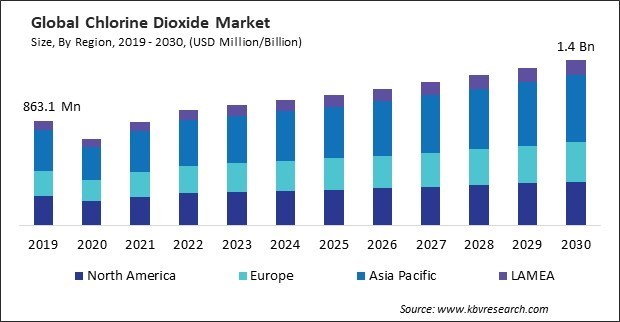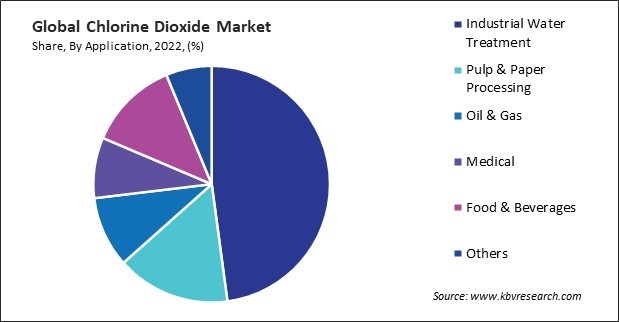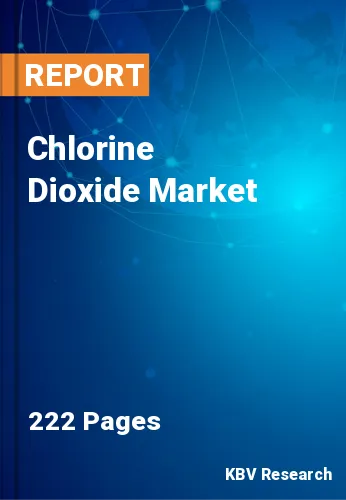“Global Chlorine Dioxide Market to reach a market value of USD 1.4 Billion by 2030 growing at a CAGR of 4.7%”
The Global Chlorine Dioxide Market size is expected to reach $1.4 billion by 2030, rising at a market growth of 4.7% CAGR during the forecast period. In the year 2022, the market attained a volume of 3,517.6 hundred tonnes, experiencing a growth of 3.9% (2019-2022).
Stringent regulations and guidelines for water quality and environmental protection often drive industries to adopt advanced water treatment solutions, including ClO2. Consequently, the industrial water treatment segment captured $459.4 million revenue in the market in 2022. Expanding industries, especially in emerging economies, can increase demand for water treatment solutions to address the environmental impact of industrial activities. Thus, these factors will boost the demand in the segment.

Chlorine dioxide stands out for its exceptional broad-spectrum disinfection capabilities. It acts as a potent oxidizing agent, disrupting bacteria and viruses' cell walls and metabolic processes. This makes it highly effective in ensuring the microbial safety of water intended for consumption, industrial processes, and commercial applications. Municipalities rely on ClO2 for treating drinking water supplies. Additionally, the food processing industry operates under rigorous hygiene and safety regulations to ensure that food products are free from contaminants that could pose health risks to consumers. It plays a crucial role in this industry by providing an effective means of disinfection. ClO2, with its demonstrated efficacy and compliance with regulatory requirements, aligns well with these standards, further driving its adoption in environments where maintaining a hygienic setting is paramount. Owing to these aspects, the market will grow rapidly in the upcoming years.
However, regulatory bodies worldwide impose concentration limits on ClO2 to ensure the safety of water treatment processes and the environment. Manufacturers and users need to stay abreast of these limits, which vary based on the intended application and local regulations. Continuous monitoring and adjustment of ClO2 concentrations are necessary to maintain compliance. Manufacturers and users need to invest in advanced monitoring technologies to meet regulatory requirements. Continuous monitoring of ClO2 concentrations, residual levels, and environmental impacts is essential. This investment ensures compliance and enables prompt corrective actions if deviations from regulatory standards occur. Thus, these factors can restrain the demand in the market.
Based on application, the market is divided into industrial water treatment, pulp & paper processing, oil & gas, medical, food & beverages, and others. The food and beverages segment procured a promising growth rate in the market in 2022. In food processing facilities, surfaces and equipment can be disinfected with ClO2, promoting hygiene and preventing the spread of pathogens. It is used for water treatment in the food and beverage industry, ensuring that water used in production processes is free from harmful microorganisms. Hence, the segment will grow rapidly in the upcoming years.

By region, the market is segmented into North America, Europe, Asia Pacific, and LAMEA. In 2022, the Asia Pacific segment acquired the highest revenue share in the market. Asia Pacific has been at the forefront of adopting stringent environmental regulations. It is favored over traditional chlorine-based disinfectants due to its lower environmental impact. Companies in the region may choose ClO2 to comply with these regulations and meet consumer preferences for sustainable practices. Hence, the segment will expand rapidly in the coming years due to these factors.
Free Valuable Insights: Global Chlorine Dioxide Market size to reach USD 1.4 Billion by 2030
| Report Attribute | Details |
|---|---|
| Market size value in 2022 | USD 959.7 Million |
| Market size forecast in 2030 | USD 1.4 Billion |
| Base Year | 2022 |
| Historical Period | 2019 to 2021 |
| Forecast Period | 2023 to 2030 |
| Revenue Growth Rate | CAGR of 4.7% from 2023 to 2030 |
| Number of Pages | 222 |
| Number of Table | 390 |
| Quantitative Data | Volume in Hundred Tonnes, Revenue in USD Billion, and CAGR from 2019 to 2030 |
| Report coverage | Market Trends, Revenue Estimation and Forecast, Segmentation Analysis, Regional and Country Breakdown, Porter’s 5 Forces Analysis, Company Profiling, Companies Strategic Developments, SWOT Analysis, Winning Imperatives |
| Segments covered | Application, Region |
| Country scope |
|
| Companies Included | Ecolab, Inc., Grundfos Holding A/S, Evoqua Water Technologies Corporation, BASF SE, DuPont de Nemours, Inc., LANXESS AG, Tecme Srl, The Chemours Company, ProMinent GmbH and Accepta Ltd |
By Application (Volume, Hundred Tonnes, USD Billion, 2019-2030)
By Geography (Volume, Hundred Tonnes, USD Billion, 2019-2030)
This Market size is expected to reach $1.4 billion by 2030.
Increasing usage due to efficiency in water treatment are driving the Market in coming years, however, Growing health and safety concerns restraints the growth of the Market.
Ecolab, Inc., Grundfos Holding A/S, Evoqua Water Technologies Corporation, BASF SE, DuPont de Nemours, Inc., LANXESS AG, Tecme Srl, The Chemours Company, ProMinent GmbH and Accepta Ltd
In the year 2022, the market attained a volume of 3,517.6 hundred tonnes, experiencing a growth of 3.9% (2019-2022).
The Asia Pacific region dominated the Market by Region in 2022, and would continue to be a dominant market till 2030; there by, achieving a market value of $556.9 million by 2030.
Our team of dedicated experts can provide you with attractive expansion opportunities for your business.

 Drivers
Drivers
 Restraints
Restraints
 Opportunities
Opportunities
 Challenges
Challenges
